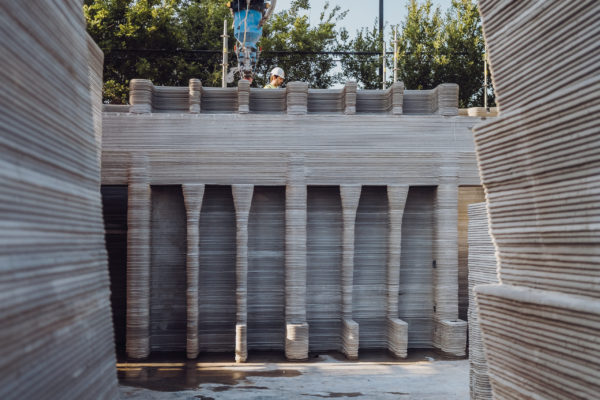Pre-construction
 Pre-construction occurs before ground is broken and is sometimes referred to as the “getting ready” or “prep” phase. This is the stage at which meetings involving the general contractor, client, architect, and the subcontractors, often happen. The involved parties review the construction plans, ensure everyone is working with up-to-date and accurate information, and establish a timeline. Although many sources may suggest that this is the point at which secure lines of communication are established, it is highly recommended that these lines of communication with the client, their general contractor, architect, subcontractors, and other personnel, is already well established during or directly after the client selects a general contractor.
Pre-construction occurs before ground is broken and is sometimes referred to as the “getting ready” or “prep” phase. This is the stage at which meetings involving the general contractor, client, architect, and the subcontractors, often happen. The involved parties review the construction plans, ensure everyone is working with up-to-date and accurate information, and establish a timeline. Although many sources may suggest that this is the point at which secure lines of communication are established, it is highly recommended that these lines of communication with the client, their general contractor, architect, subcontractors, and other personnel, is already well established during or directly after the client selects a general contractor.
Following the pre-construction period, most steps are spearheaded and overseen by the general contractor.
Material Procurement
The client may be involved in this step, but usually, the responsibility of material, labor, and equipment procurement falls exclusively on the general contractor. The construction project is at the highest risk of bottlenecks and delays at this point. Additionally, this step is where a great general contractor will stand out against a good one. A general contractor who plans, schedules, and budgets well may still experience unexpected delays. However, a general contractor who plans, schedules, and budgets well who also has good, strong connections with the construction sector, including banks, suppliers, subcontractors, and delivery drivers is more likely to avoid encountering unexpected delays.
Material procurement at an early stage, will not only assist in alleviating delays but will also help ensure that the quoted pricing does not increase. Especially right now, material prices fluctuate like a rollercoaster, locking in prices early on is a common practice among good general contractors. Another thing to consider asking your chosen GC is do they have in-house procurement specialists or if they contract with someone specific. Having this knowledge ahead of time will help you know what to expect when it comes to the procurement of building supplies stage.
Site Preparation and Groundwork
 Site preparation and groundwork involves preparing the construction site for the building that is to be constructed, the construction equipment, and the construction workers and personnel. It often includes steps such as clearing the land, laying foundations, land excavation, and setting up worker facilities and utilities. This is typically the phase in which subcontractors are first employed. Site preparation subcontractors will perform all tasks involved in site preparation and groundwork like the ones listed above as well as tree removal and ground leveling. However, while some site preparation subcontractors may do concrete work and lay foundations, it is not uncommon for general contractors to employ a subcontractor who specializes in concrete and groundwork to perform the concrete work. This type of subcontractor typically handles tasks such as pouring, curing, and finishing concrete slabs.
Site preparation and groundwork involves preparing the construction site for the building that is to be constructed, the construction equipment, and the construction workers and personnel. It often includes steps such as clearing the land, laying foundations, land excavation, and setting up worker facilities and utilities. This is typically the phase in which subcontractors are first employed. Site preparation subcontractors will perform all tasks involved in site preparation and groundwork like the ones listed above as well as tree removal and ground leveling. However, while some site preparation subcontractors may do concrete work and lay foundations, it is not uncommon for general contractors to employ a subcontractor who specializes in concrete and groundwork to perform the concrete work. This type of subcontractor typically handles tasks such as pouring, curing, and finishing concrete slabs.
Construction
Finally, after careful preparation, construction can begin. Communication between the client, general contractor, and subcontractors is not only important, but absolutely essential at this stage.
- Framing – After site preparations and the foundation has been cured, workers start on the framing. The framing, or structural engineering of a structure, is responsible for the shape, strength, and stability of the structure. Also referred to as the “skeleton” of the building, the structural engineering consists of many elements including beams, columns, foundations. Floors may also be put in place at this phase.
- Exterior – After the framing is complete, walls and other exterior elements such as roofing are installed. Additionally, this is the stage at which windows and doors are placed. It may also involve additional subcontractors to complete any necessary brick and plasterwork. If the project utilizes 3D concrete printing technology, this is typically the stage at which it is employed.
- Rough Interior Work (MEP) – Mechanical, electrical, and plumbing (MEP), or interior work comes next. This includes tasks like installing the HVAC system, plumbing, electrical wiring, and insulation. Ventilation, gas lines, internet and television cables, lighting, waste piping, water piping, and many other elements are added here. In summary, all modern amenities that make houses and buildings comfortable occur now.
- Finishing – The finishing stage is where many of the final touches take place. This may include interior finishing like painting, tile and carpet installation, and light fixture installation. Exterior finishing also happens during this stage, typically including landscaping, driveway paving, and installing outdoor lighting.
Conclusion
The construction period consists of multiple stages requiring careful planning and consistent, informative communication. This is the period at which the project is at the highest risk of experiencing delays. However, with meticulous scheduling, detailed construction drawings, up-to-date and accurate building permits, a great general contractor, and strong lines of communication between the client and the GC, this construction period can be as smooth and efficient as possible.






